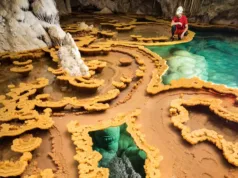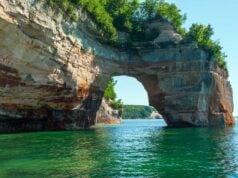The Quebrada de Humahuaca is a breathtaking and historically rich mountainous gorge located in the northwest of Argentina, in the province of Jujuy. This stunning landscape stretches for approximately 155 kilometers (96 miles) along the Rio Grande and is flanked by towering, multicolored rock formations that have been shaped by millions of years of geological processes.
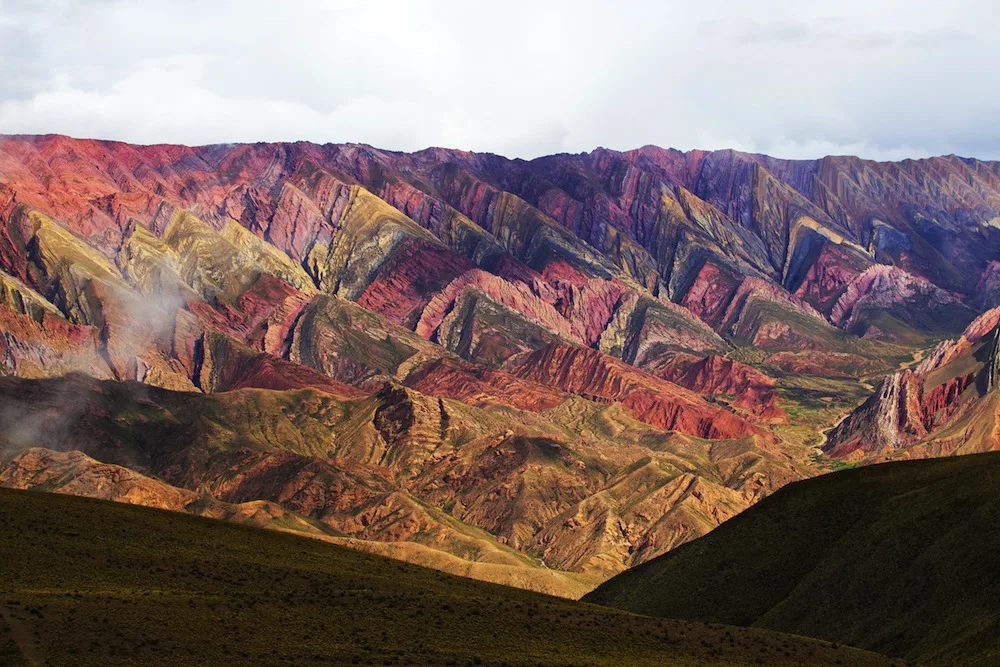
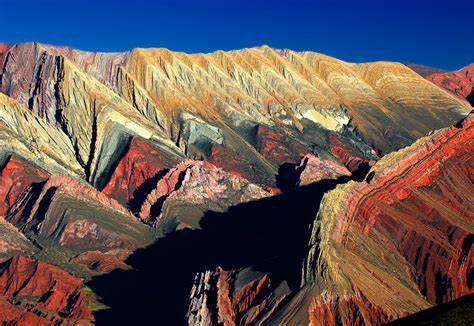
The significance of the Quebrada de Humahuaca lies in its historical, cultural, and natural importance. For thousands of years, this region has been a vital corridor for trade, communication, and cultural exchange between the Andean highlands and the lowlands of Argentina. Its strategic location has made it a melting pot of diverse cultures, including indigenous peoples such as the Quechua and the Aymara, as well as Spanish colonizers.
The Quebrada de Humahuaca has witnessed the rise and fall of numerous civilizations, and its history is etched into the landscape through archaeological sites, traditional villages, and centuries-old traditions that continue to thrive today. The region’s unique blend of indigenous and colonial influences is reflected in its architecture, art, crafts, music, and cuisine.
In recognition of its outstanding cultural and natural value, the Quebrada de Humahuaca was designated as a UNESCO World Heritage Site in 2003. This prestigious status is a testament to its significance as a living testament to the historical and cultural interactions between different societies. The UNESCO designation aims to ensure the preservation and sustainable development of the area, safeguarding its heritage for future generations to appreciate and learn from.
Visitors to the Quebrada de Humahuaca are captivated not only by its stunning geological formations but also by the tangible connection to its rich past. The gorge’s unique blend of history, culture, and natural beauty makes it a must-visit destination for travelers seeking an immersive experience in the heart of Argentina’s vibrant heritage.
Geological Formation and History

The geological formation of the Quebrada de Humahuaca is a result of a complex interplay of various geological processes that have occurred over millions of years. The gorge’s distinctive features and unique landscape can be attributed to tectonic activity, erosion, and sedimentation.
- Tectonic Activity: The Quebrada de Humahuaca lies within the broader context of the Andes mountain range, which is the result of the convergence between the South American Plate and the Nazca Plate. The ongoing tectonic collision and subduction processes have led to the uplift of the Andes and the creation of numerous mountain ranges, valleys, and gorges, including the Quebrada de Humahuaca. The tectonic forces at play have caused the Earth’s crust to deform, fold, and fault, resulting in the creation of the rugged terrain that characterizes the region.
- Erosion: Erosion has played a significant role in shaping the Quebrada de Humahuaca. Over millions of years, the combined effects of wind, water, and ice have carved out the deep gorge and sculpted the intricate rock formations. The Rio Grande, flowing through the gorge, has been a powerful agent of erosion, gradually wearing away the rock layers and widening the valley. The force of the river’s flow, especially during times of heavy rainfall and flooding, has helped to excavate the underlying rock and contribute to the deepening of the gorge.
- Sedimentation: Sedimentation, the process of deposition of eroded material, has also played a role in the formation of the Quebrada de Humahuaca. As water carries sediment downstream, it often gets deposited along the riverbanks and in the lower-lying areas. Over time, these accumulated sediments contribute to the filling of valleys and the creation of flatter areas within the gorge. The contrast between the eroded rock formations and the sediment-filled valleys adds to the visual allure of the landscape.
Throughout its geological history, the Quebrada de Humahuaca has been a dynamic environment where tectonic forces, erosion, and sedimentation have interacted to shape its distinct features. The resulting landscape showcases the intricate interplay between natural forces and the passage of time, creating a visually stunning and culturally significant setting. The geological processes that have contributed to the formation of the Quebrada de Humahuaca continue to shape the region today, albeit at a much slower pace, and serve as a reminder of the Earth’s ever-changing nature.
Stratigraphy and Rock Types
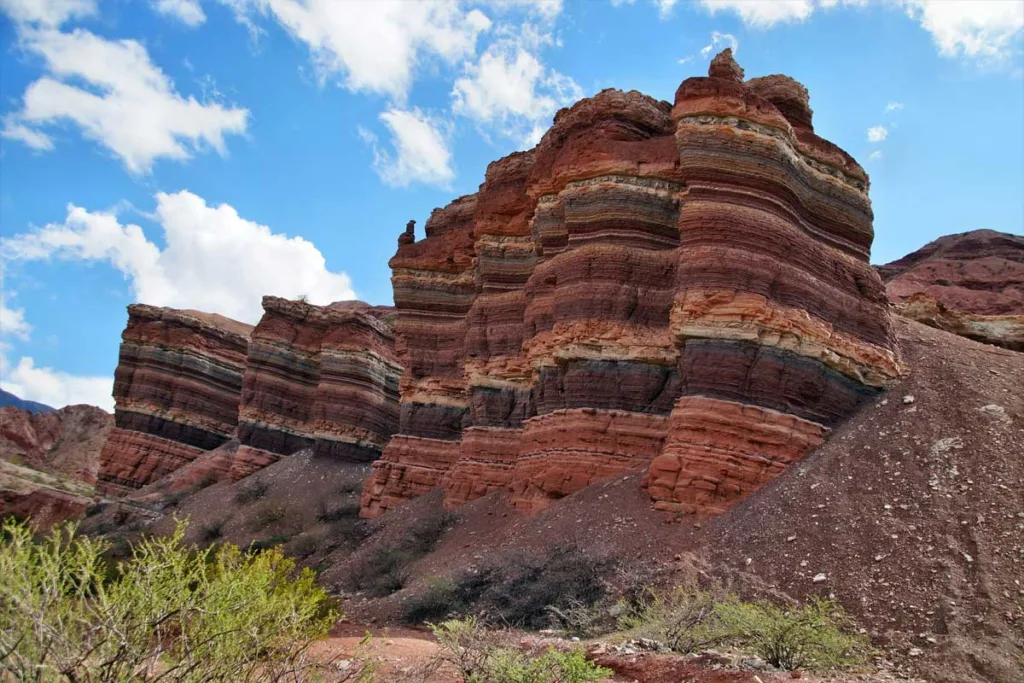
The Quebrada de Humahuaca is characterized by a diverse range of rock formations that provide insight into its geological history and the processes that have shaped the landscape. These rock formations can be broadly categorized into three main types: sedimentary, igneous, and metamorphic rocks.
- Sedimentary Rocks: Sedimentary rocks are formed through the accumulation and compaction of sediments over time. In the Quebrada de Humahuaca, sedimentary rocks are prominent and often showcase layers that represent different periods of deposition. These rocks offer valuable clues about the ancient environments and conditions that existed in the region. Examples of sedimentary rocks found in the Quebrada de Humahuaca include:
- Sandstone: Sandstone is a common sedimentary rock composed primarily of sand-sized mineral particles. It often appears as distinct layers in the rock formations of the gorge.
- Shale: Shale is a fine-grained sedimentary rock composed of clay and silt-sized particles. It can exhibit layers that are rich in fossils and provide insights into past ecosystems.
- Limestone: Limestone is a sedimentary rock composed mainly of calcium carbonate. It can form in marine environments and may contain fossils of marine organisms.
- Igneous Rocks: Igneous rocks are formed from the solidification of molten material, either beneath the Earth’s surface (intrusive) or on the surface (extrusive). While sedimentary rocks dominate the Quebrada de Humahuaca’s landscape, igneous rocks also play a role. Examples include:
- Andesite: Andesite is an extrusive igneous rock that is commonly associated with volcanic activity. It often has a fine-grained texture and can form as lava flows or volcanic ash deposits.
- Granite: Granite is an intrusive igneous rock characterized by its coarse-grained texture. It forms when magma cools and solidifies deep within the Earth’s crust. Granite may be exposed through erosion and contribute to the geological diversity of the region.
- Metamorphic Rocks: Metamorphic rocks are formed from the alteration of existing rocks due to changes in temperature, pressure, or mineral composition. While not as abundant as sedimentary rocks in the Quebrada de Humahuaca, some metamorphic rocks can be found. Examples include:
- Schist: Schist is a metamorphic rock with a well-developed foliation (layering) due to the alignment of mineral grains. It often forms from the metamorphism of pre-existing shale or other sedimentary rocks.
- Gneiss: Gneiss is a high-grade metamorphic rock characterized by distinct light and dark layers. It forms from the metamorphism of rocks like granite or sedimentary rocks.
The presence of these diverse rock types in the Quebrada de Humahuaca reflects the complex geological history of the region, involving processes such as sediment deposition, volcanic activity, and tectonic forces. The intricate layering, colors, and textures of the rock formations contribute to the gorge’s stunning visual appeal and provide geologists and researchers with valuable information about the Earth’s past.
Sedimentary Layers and Fossil Record
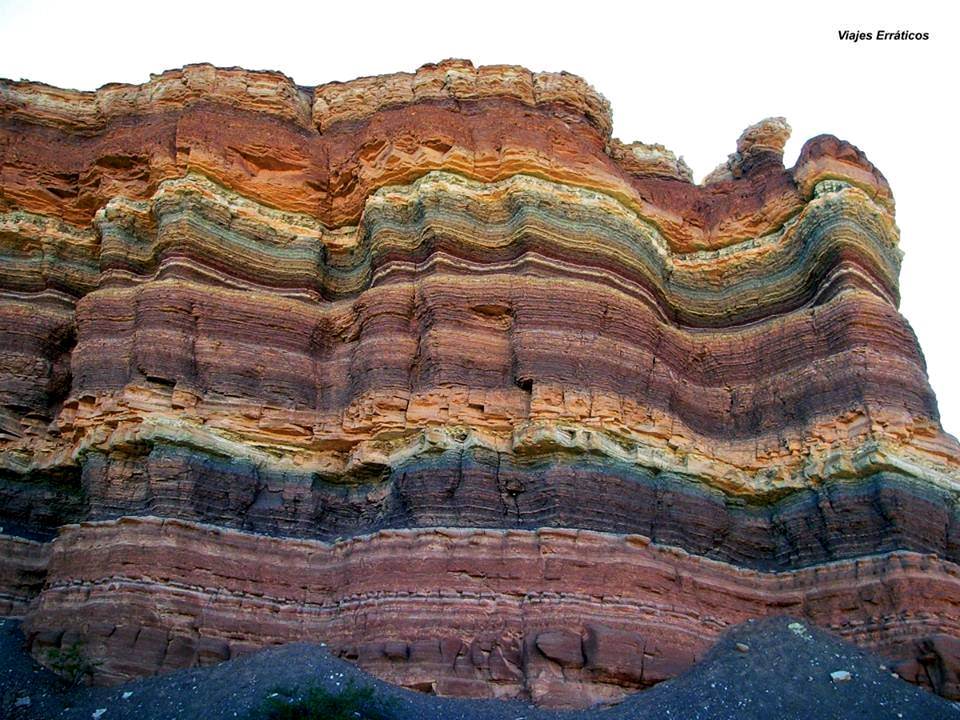
The sedimentary layers within the Quebrada de Humahuaca provide a valuable record of the region’s geological history and past environments. These layers, often visible in the exposed rock formations, offer insights into the changing landscapes, climate conditions, and ecosystems that have existed over millions of years. The study of these sedimentary layers, combined with the fossil record found within them, allows scientists to reconstruct the history of the area.
- Sedimentary Layers: The sedimentary layers in the Quebrada de Humahuaca represent different periods of deposition and can be observed in the distinct horizontal bands or strata within the rock formations. These layers are a result of the accumulation of sediment, such as sand, silt, clay, and organic material, over time. As new sediment is deposited, it forms a new layer on top of the older ones, creating a chronological record of geological events.
- Fossil Record: The fossil record found within the sedimentary layers of the Quebrada de Humahuaca provides a window into the past ecosystems and the organisms that inhabited the region. Fossils preserved in these rocks include the remains of plants, animals, and even microorganisms. These fossils can include bones, shells, teeth, plant fragments, and tracks left behind by ancient creatures.The significance of the fossil record in the Quebrada de Humahuaca lies in its ability to:
- Reconstruct Environments: By analyzing the types of organisms and their characteristics, scientists can infer the types of environments that existed in the past. For example, the presence of marine fossils in certain layers suggests that the region was once covered by seas or oceans.
- Track Evolutionary Changes: Fossils provide evidence of the evolution and adaptation of species over time. Studying changes in the morphology of fossilized organisms can help researchers understand how life has evolved in response to changing conditions.
- Climate Reconstruction: Certain fossils, such as plant types that are indicative of specific climatic conditions, can provide information about past climates. This data is crucial for understanding how climates have changed over geological time scales.
- Biodiversity and Extinctions: The fossil record can reveal periods of high biodiversity and mass extinctions, shedding light on the complex interactions between species and environmental changes.
Landforms and Geological Features
The Quebrada de Humahuaca is renowned for its spectacular and iconic landforms that showcase the intricate interplay of geological processes over millions of years. Some of the notable features include colorful mountains, dramatic canyons, and unique rock formations. These landforms are a testament to the region’s geological history and the forces that have shaped its breathtaking landscape.
- Colorful Mountains and Canyons: One of the most striking features of the Quebrada de Humahuaca is the vibrant array of colors that adorn its mountains and canyons. The rich palette of reds, yellows, oranges, and purples creates a mesmerizing visual spectacle. These colors are primarily attributed to the diverse composition of sedimentary rocks found in the area, particularly sandstone and shale. The varying mineral content, along with the effects of weathering and oxidation, contribute to the vivid hues that adorn the landscape.
- Rock Formations: The Quebrada de Humahuaca is characterized by a variety of unique and intricate rock formations that captivate visitors with their distinct shapes and textures. These formations are the result of a combination of tectonic activity, erosion, and sedimentation. Some notable rock formations include:
- Folded Rocks: The region’s complex geological history has led to the folding of sedimentary rock layers, creating undulating patterns and ridges. These folds are a result of the immense pressure and deformation caused by tectonic forces over time.
- Eroded Sandstone Pillars: The erosion of softer rock layers over harder ones has given rise to fascinating formations such as sandstone pillars, which jut out from the landscape like natural sculptures. These pillars are the product of differential weathering and erosion rates among the various rock layers.
- Cuestas and Hogbacks: Cuestas are elongated, asymmetrical ridges formed by the erosion of alternating layers of resistant and less resistant rocks. Hogbacks are similar but have steeply inclined sides. Both cuestas and hogbacks contribute to the region’s distinctive topography.
Overall, the Quebrada de Humahuaca’s iconic landforms are a result of the ongoing interplay between tectonic forces, erosion by wind and water, and the deposition of sediments. The region’s geological history is recorded in the layers of rock and the sculpted formations, offering a fascinating glimpse into the dynamic processes that have shaped this remarkable landscape.
Mineral Deposits and Resources
The Quebrada de Humahuaca has a history of mineral deposits that have attracted human activity for centuries. While the region is not particularly known for large-scale mining, it has hosted various minerals of economic and cultural significance. These minerals have played a role in the development of local communities and have contributed to the region’s historical and contemporary mining activities.
- Minerals of Economic Importance:
- Salt: Salt deposits have been historically important in the Quebrada de Humahuaca. The salt flats in the area, such as the Salinas Grandes, have provided a source of salt for both consumption and preservation of food.
- Lead and Zinc: The region has also seen mining activities for lead and zinc, primarily in the form of galena (lead sulfide) and sphalerite (zinc sulfide) minerals. These minerals have been extracted for their metal content.
- Copper: While not as prominent as other minerals, copper deposits have been found in the Quebrada de Humahuaca. Copper has been used for various purposes, including tools, ornaments, and decorative items.
- Historical and Contemporary Mining Activities:
- Pre-Columbian Mining: Indigenous peoples in the region engaged in small-scale mining of minerals for local use. They extracted salt from salt flats and used mineral resources for crafting tools, ornaments, and ritual items.
- Colonial and Post-Colonial Periods: During the Spanish colonial era, mining activities in the Quebrada de Humahuaca focused on extracting precious metals, such as silver and gold. The Spanish established mines and exploited mineral resources to support their colonial interests.
- Modern Times: In more recent times, the mining activities in the Quebrada de Humahuaca have been limited in scale and scope. While some small-scale mining operations for minerals like lead, zinc, and copper have continued, the emphasis has shifted towards preserving the region’s cultural and natural heritage.
It’s important to note that the Quebrada de Humahuaca is now a UNESCO World Heritage Site, and efforts have been made to balance the preservation of its unique cultural and natural features with sustainable development and tourism. As a result, mining activities are generally subject to regulations to ensure minimal environmental impact and the protection of the region’s historical and cultural heritage.
In summary, while mineral deposits have played a role in the history and development of the Quebrada de Humahuaca, contemporary mining activities are limited and often regulated to maintain the integrity of the UNESCO World Heritage Site. The region’s mineral resources continue to contribute to local culture and traditions, but the focus has shifted towards preserving the area’s exceptional natural and cultural value.
Geological Evolution and Environmental Changes
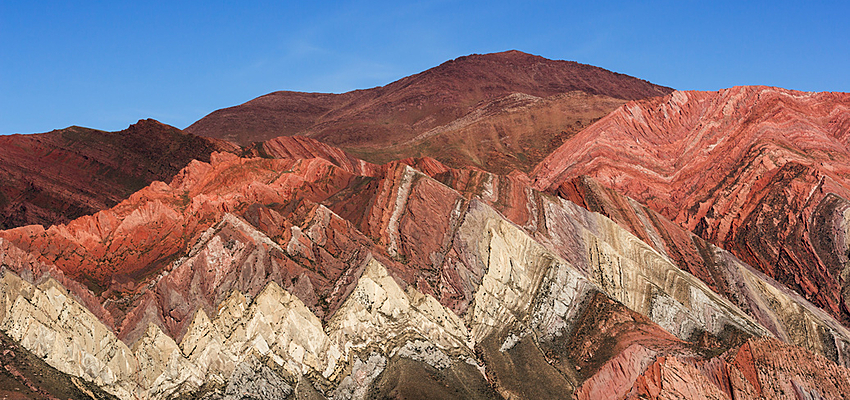
The geological evolution of the Quebrada de Humahuaca spans millions of years and has been shaped by a complex interplay of geological processes. This evolution has had a profound impact on the region’s ecosystems and habitats, influencing the types of plants, animals, and environments that have thrived in the area.
- Ancient Marine Environments: The geological history of the Quebrada de Humahuaca dates back to a time when the region was covered by ancient seas. Sedimentary rocks, including limestone and shale, found in the gorge are evidence of these past marine environments. Fossilized marine organisms preserved in these rocks provide insights into the prehistoric life that inhabited the area.
- Tectonic Uplift and Mountain Building: The uplift of the Andes, driven by tectonic forces and the collision of the South American and Nazca plates, has played a pivotal role in shaping the landscape of the Quebrada de Humahuaca. Mountain-building processes have led to the formation of rugged terrain, elevated plateaus, and deep valleys, creating diverse habitats and ecological niches.
- Climate Fluctuations: The region’s geological history has been marked by shifts in climate over millions of years. These climatic changes have influenced vegetation patterns, water availability, and the distribution of species. Fluctuations between wetter and drier periods have likely shaped the types of ecosystems that have developed in the Quebrada de Humahuaca.
- Erosion and Sedimentation: The erosional forces of water, wind, and ice have sculpted the Quebrada de Humahuaca’s distinct landforms, including canyons, colorful mountains, and rock formations. Erosion has exposed different rock layers, each representing a specific time period in the region’s geological history. This dynamic process has created a mosaic of habitats and microhabitats that support a variety of plant and animal species.
- Biodiversity and Adaptation: The geological changes in the Quebrada de Humahuaca have contributed to the region’s rich biodiversity. As the landscape evolved, plant and animal species adapted to the changing conditions, leading to the development of unique ecosystems. The juxtaposition of different rock types, elevation gradients, and microclimates has contributed to the creation of diverse habitats that support a wide range of species.
- Human Influence: Human activities, including prehistoric and historic settlements, agriculture, and more recently, tourism, have interacted with the geological and environmental processes in the Quebrada de Humahuaca. These activities have shaped the landscape, altered habitats, and influenced the distribution of species.
In summary, the geological evolution of the Quebrada de Humahuaca has been a dynamic and multifaceted process that has shaped the region’s landscapes, habitats, and ecosystems over millions of years. The interplay of tectonic activity, erosion, sedimentation, and climatic fluctuations has contributed to the diverse array of geological features and ecological niches found within the gorge. Understanding this geological history is crucial for appreciating the complex interactions between the Earth’s physical processes and the natural world.
Cultural Significance and Geology
The unique geology of the Quebrada de Humahuaca has had a profound influence on the cultural identity, traditions, and art of the local communities that have inhabited the region for centuries. The geological features and landscapes of the gorge have played a pivotal role in shaping human settlement patterns, inspiring artistic expressions, and fostering a strong connection between the people and their environment.
- Settlement Patterns and Land Use: The geological formations of the Quebrada de Humahuaca have influenced where and how human communities settled in the region. The availability of fertile soils, water sources, and natural shelters provided by rock formations often determined the location of villages and agricultural activities. The towering cliffs and canyons also served as natural defenses, contributing to the strategic placement of settlements.
- Cultural Practices and Traditions: The distinctive geology of the region has become intertwined with local cultural practices and traditions. Indigenous communities have attributed spiritual and symbolic significance to certain rock formations, mountains, and natural landmarks. These features often have mythological or ceremonial importance, reflecting the deep connection between the people and the land.
- Art and Craftsmanship: The vibrant colors, textures, and shapes of the geological formations have inspired local artisans to incorporate these elements into their artwork and crafts. Traditional textiles, ceramics, and other crafts often reflect the natural beauty of the landscape. Geometric patterns and motifs found in indigenous art may draw inspiration from the layered rock formations or the play of light and shadow on the mountains.
- Storytelling and Oral Traditions: The geological features of the Quebrada de Humahuaca have been woven into local storytelling and oral traditions. These stories, passed down through generations, often involve natural landmarks and geological events, further cementing the connection between the people and their surroundings.
- Tourism and Cultural Identity: The unique geology of the Quebrada de Humahuaca has also attracted tourists and researchers interested in its cultural and natural heritage. The presence of UNESCO World Heritage status highlights the global recognition of the region’s significance. Tourism has both economic and cultural implications, allowing local communities to share their traditions and stories with visitors while also fostering a sense of pride in their heritage.
Overall, the geological features of the Quebrada de Humahuaca have not only provided practical resources for human communities but have also contributed to a deep cultural and spiritual connection between the people and their environment. The interaction between geology and culture in the Quebrada de Humahuaca exemplifies how the natural world can shape and enrich the human experience, fostering a unique and vibrant cultural identity that is inseparable from the landscape itself.
Tourism and Sustainable Development
Tourism plays a significant role in the local economy of the Quebrada de Humahuaca, providing opportunities for economic growth, job creation, and cultural exchange. However, striking a balance between tourism and the preservation of the region’s cultural and environmental heritage is crucial to ensure sustainable development and long-term well-being for both the local communities and the natural landscape.
Importance of Tourism for the Local Economy:
- Economic Growth: Tourism generates revenue and stimulates economic growth by creating employment opportunities in various sectors, including hospitality, transportation, food services, and crafts. It contributes to increased income levels and economic diversification.
- Cultural Exchange: Tourism fosters cultural exchange between visitors and local communities, allowing for the sharing of traditions, crafts, and stories. This exchange can contribute to cultural preservation, pride, and a deeper understanding of heritage.
- Infrastructure Development: Tourism often leads to improvements in local infrastructure, such as transportation, accommodations, and public services, which can benefit both residents and visitors.
Balancing Tourism with Preservation:
- Cultural Preservation: It’s essential to manage tourism in a way that respects and preserves the cultural heritage of the local communities. This can involve promoting responsible tourism practices that prioritize authentic cultural experiences, support local traditions, and engage the community in tourism development decisions.
- Environmental Conservation: Sustainable tourism practices should minimize negative impacts on the environment. This includes measures to reduce pollution, waste, and resource consumption. Protecting ecologically sensitive areas and promoting responsible outdoor activities are crucial for preserving the natural beauty and biodiversity of the region.
- Community Involvement: Engaging local communities in the planning and management of tourism activities empowers them to take an active role in shaping their own development. Their input can help ensure that tourism initiatives align with their cultural values and aspirations.
- Carrying Capacity: Establishing and enforcing limits on the number of tourists or activities in certain areas can prevent overcrowding and environmental degradation. Monitoring visitor numbers and setting appropriate limits based on the capacity of the environment is a key strategy.
- Education and Awareness: Promoting responsible tourism behaviors among visitors, such as respecting local customs, minimizing waste, and supporting local businesses, can contribute to a positive and sustainable tourism experience.
- Regulation and Enforcement: Implementing regulations and guidelines for tourism operators and visitors can help ensure that activities are conducted in a manner that respects cultural heritage and minimizes negative environmental impacts.
In essence, the Quebrada de Humahuaca can benefit from well-managed and sustainable tourism that respects and enhances its cultural and environmental assets. By considering the needs and aspirations of local communities and implementing responsible tourism practices, the region can achieve a harmonious balance between economic growth, cultural preservation, and environmental conservation.


























